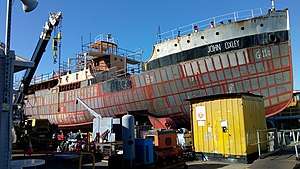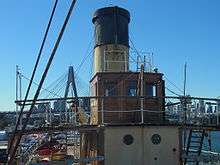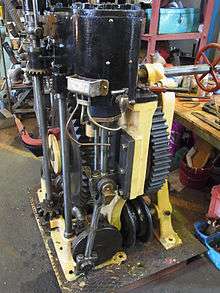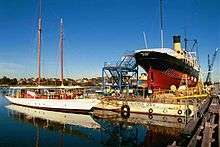SS John Oxley
SS John Oxley is a steamship that previously served as a pilot boat and lighthouse and buoy tender.[2] The ship was built in Scotland in 1927 for the Queensland Government. The vessel was requisitioned by Royal Australian Navy during the World War II. Returned to her duties after the war, John Oxley remained active until 1968, when her deteriorating condition made her unusable. In 1970, the ship was donated by the Queensland Government to the Lady Hopetoun and Port Jackson Marine Steam Museum (now the Sydney Heritage Fleet) for preservation, but due to other projects, work was sidelined until 2004. As of 2017, the ship is undergoing restoration at Rozelle Bay.
 John Oxley in July 2018, undergoing restoration at the Sydney Heritage Fleet shipyard in Rozelle Bay | |
| History | |
|---|---|
| Name: | SS John Oxley |
| Owner: |
|
| Operator: | Royal Australian Navy (World War II) |
| Builder: | Bow, McLachlan & Co, Paisley, Scotland |
| Yard number: | 464 |
| Launched: | 20 July 1927 |
| In service: | 1927 |
| Out of service: | 1968 |
| Homeport: |
|
| Identification: | IMO number: 5174234 |
| Status: | Undergoing restoration |
| General characteristics | |
| Type: | Pilot boat[1] |
| Tonnage: | 544 GRT |
| Displacement: | 760 DWT |
| Tons burthen: | 212 NRT |
| Length: | 168 ft (51 m) |
| Beam: | 32 ft (9.8 m) |
| Draught: | 11 ft (3.4 m) |
| Installed power: | 1,400 IHP |
| Propulsion: | triple expansion steam engine supplied by two Scotch boilers |
| Speed: | 14 knots (26 km/h; 16 mph) |
| Capacity: | 14 pilots |
| Crew: | 15 crew |
| Armament: | One Oerlikon 20 mm cannon (naval service) |
Design and construction
Bow, McLachlan and Company of Paisley in Renfrewshire, Scotland built John Oxley in 1927, under yard number 464.[1] She was launched on 20 July 1927, and completed later that year.[1] The vessel is 168 feet (51 m) long, with a beam of 32 feet (9.8 m), and a draught of 11 feet (3.4 m).[1] Tonnage values are 544 Gross register tonnage, 760 Deadweight tonnage, and 212 Net Register Tonnage[1] Propulsion is provided by two Scotch marine boilers supplying a triple expansion steam engine, which delivers 1,400 IHP to the propeller, for a maximum speed of 14 knots (26 km/h; 16 mph).[1][2] The vessel had a crew of 15, and in her role as a pilot boat, could carry 14 harbour pilots.[1][3]
Service career

In early October 1927, John Oxley left Greenock, Scotland bound for Brisbane via the Red Sea and Indian Ocean. While en route in the Mediterranean Sea, she responded to a distress signal by the tugboat Jackstay and towed it to Malta. It arrived in Brisbane on 9 December 1927.[4]
She was delivered to the Government of Queensland Harbours and Marine Department, whom she served as a pilot boat in Moreton Bay[1] and buoy tender and lighthouse tender along the Queensland coast.[2]
During World War II, John Oxley was requisitioned by the Royal Australian Navy and a 20mm Oerlikon anti-aircraft gun was mounted on the stern. She was returned to her former duties in 1946, and converted from coal to oil fuel that same year.
John Oxley continued to serve as a pilot tender, lighthouse and buoy tender until 1968 when she was decommissioned. In her later years she had become increasingly decrepit, such that in 1964 the Seamen's Union of Australia's journal called her a "rust heap" with "the worst living conditions of any ship on the entire Australian coast".[5]
Preservation

John Oxley was donated to the Lady Hopetoun and Port Jackson Marine Steam Museum (now the Sydney Heritage Fleet) , arriving in Sydney in August 1970 and initially moored at Birkenhead Point.[2][6] She saw very little repair work until 1997, when restoration on another ship, the barque James Craig, was at a stage where she could be taken off the floating dock. Until then, its hull had gradually deteriorated and she was badly in need of repairs when put on the floating dock in place of the James Craig.
Since 2002 the John Oxley has been under continuous restoration on land at the Heritage dockyard of the Sydney Heritage Fleet, Rozelle Bay.[7] During eighty years on the water, the ship had incurred substantial corrosion to the hull, decks and superstructure. The majority of the plates of the ship's riveted hull have required complete replication using the same hot riveted method as when the ship was built.
The restoration work also entails the repair and reconditioning of all machinery, masts and rigging, timber work, internal fitout and generally making the ship seaworthy. The ship will satisfy the survey requirements for safe operation and make coastal voyages.[7]
Gallery
 John Oxley on floating dock in 2005
John Oxley on floating dock in 2005 Wheelhouse and bridge superstructure in 2005
Wheelhouse and bridge superstructure in 2005 Hot riveting hull plates in 2006
Hot riveting hull plates in 2006 John Oxley and the schooner Boomerang in 2005
John Oxley and the schooner Boomerang in 2005 SS John Oxley on floating dock in 2013
SS John Oxley on floating dock in 2013 After being removed from the ship for restoration the teak wheelhouse was refitted on July 10, 2018
After being removed from the ship for restoration the teak wheelhouse was refitted on July 10, 2018 Refitted propeller in 2018
Refitted propeller in 2018 Returning wheelhouse to ship in 2018
Returning wheelhouse to ship in 2018 Restored wheelhouse in 2018
Restored wheelhouse in 2018
References
Notes
- Cameron, Stuart; Robinson, George. "SS John Oxley". Clyde-built Database. Archived from the original on 4 March 2016. Retrieved 22 May 2011.CS1 maint: unfit url (link)
- "History of John Oxley". Sydney Heritage Fleet. Archived from the original on 3 December 2017. Retrieved 3 December 2017.
- John Oxley Daily Commercial News & Shipping List 30 September 1927 page 5
- "NEW PILOT STEAMER". The Brisbane Courier (21, 801). Queensland, Australia. 10 December 1927. p. 28. Retrieved 4 December 2017 – via National Library of Australia.
- Seaman's Union newspaper, reprinted in Seccombe, Ralph (August 2008). "Upstairs, Downstairs". Australian Sea Heritage. Sydney: Sydney Maritime Museum Ltd (92): 9–14.
- Ship Ahoy! Trolley Wire issue 131 December 1970 page 16
- "John Oxley restoration Update Jan 2011". Sydney Heritage Fleet. Archived from the original on 25 February 2011. Retrieved 22 May 2011.
Bibliography
Mollema, Hette (2010), SS John Oxley : Restoration Underway, Hette Mollema, ISBN 978-0-646-54234-8